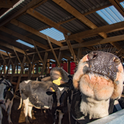Nine years after the last series ended, Gilmore Girls returned to screens today with four 90-minute episodes on Netflix. The sitcom follows Lorelai, a sharp-tongued, free-spirited single mother, bringing up her gifted daughter Rory—the result of a teenage pregnancy. Over seven series, amid a swirl of fast-paced dialogue, we saw Rory (Alexis Bledel) grow up in real time. In the new season, entitled “A Year in the Life,” Lorelai (Lauren Graham) is now 48, and Rory is 32—the same age her mother was in series one. It’s a nice touch of symmetry that makes the revival seem particularly well-timed.
The new episodes are timely for a different reason: 2016 has marked a significant year for female-centred television comedy. We saw the wildly successful premiere of Fleabag on BBC Three, as well as the new series ofBroad City, Girls, The Unbreakable Kimmy Schmidt, and Inside Amy Schumer. All these shows feature funny women in lead roles, and are specifically concerned with female issues—a trend that even five years ago would have been highly unlikely.
Just because they feature women in the lead, doesn’t preclude a strong male following. According to a poll published in Vulture, 56 per cent of live viewership for the first season of Girls were men (22 per cent were men aged over 50). In a recent interview with the Financial Times, Ian Hislop mentioned that he found Fleabag “incredibly funny.” That a show about a dry-witted female sex addict should be endorsed by a caustic middle-aged man like Hislop, let alone in the Financial Times, demonstrates how far the demographic for these shows has shifted.
Indeed, it seems a long time since 2007. That year not only saw the end of Gilmore Girls, but the publication of a Vanity Fair article entitled “Why Women Aren’t Funny.” Its author was Christopher Hitchens: another caustic middle-aged man cut from the same cloth as Hislop. Peppered with characteristically provocative asides, Hitchens’s article concluded that women were too weighed down with the burden of life to be able to take it lightly.
The argument was preposterous (one suspects purposefully so), yet clothed in Hitchens’ elegant language, it seemed to carry enough weight to provoke a reaction from a group of prominent female comics, including Tina Fey and Sarah Silverman. A clash of the sexes ensued, with Hitchens refusing to concede. “What has been the achievement of my essay?” he said in a response Youtube video. “It’s been to make sexier women try harder to amuse me. That was my whole plan to start off with.”
Though the gender divide seems now less sharply defined, that remark resonates. Why are men are so interested in shows like Girls andFleabag? Is it purely based on their comic quality? Is it because we have accepted women can be as funny as men? Or might it be, instead, because men rather enjoy watching attractive women in their twenties talk openly about sex? Those who stick to the latter argument too closely should bear in mind that men hated Sex and the City: though Fleabag, Inside Amy Schumer and Broad City are joyfully vulgar, they clearly have genuine merit outside of their confrontations with sex. (Fleabag is especially good at exposing the problematic aspects of this.) But there is nevertheless something a bit tiresome about their never-ending tide of sex jokes.
That is why a wholesome feminist show like Gilmore Girls is now oddly refreshing. A few minutes into the first episode of the new season, the world of Stars Hollow seems cosy as ever. Snowflakes fall, jingle bells are heard, the “lalala” song plays over the top and we see Lorelai sat in the gazebo. Rory, now a freelance journalist, is returning home to see her mother. She’s not the only one who’s back: there’s Luke, Lane, Miss Patty, Michel, Logan, Dean and Jess (whose biceps are literally as wide as his head), and even the troubadour (who is territorial as ever).
Yet there are two notable exceptions from the cast reunion: Sookie, played by Melissa McCarthy, and Lorelai’s father Richard, played by the late Edward Herrman. Rather than skirt around these absences, they are explained in detail. Sookie has gone to find herself: “She’s squatting in a cabin trying to make a pineapple out of a coat-rack,” says Michel. "She's abandoned us." (Might this be a nod to McCarthy’s new Hollywood fame?) Richard, like Herrman, has recently passed away. This gives a sad tinge of reality to the show that sets it apart from previous seasons. Moreover, without the patriarchal figure of Herrman acting as a mediator, we are able to see how fraught the relationship remains between Lorelai and her mother Emily. Their interactions are pitch-perfect.
If Lorelai and Emily are having problems, Rory is snowed under. In previous seasons she was always rather annoying: the nicey-nice goody-two-shoes who always had the moral high ground, and was destined for success. Now we see that things have not worked out as planned. She not only lacks the stability of a home and full-time job, but flip-flops between men, even meddling in other people’s relationships. Seeing how flawed and frustrated Rory has become makes this less comfortable watching than may be expected.
Though much of the reboot is coherent and nuanced, there are a few issues. Mr Kim pops up for a blink-and-you’ll miss it appearance at the beginning of episode three that is never explained. The pop-culture references, so seamlessly threaded into the dialogue in previous seasons, often seem a bit self-conscious here (Lorelai: “I’m organising my magazines by Kardshian”). But there are occasional zingers delivered with perfect bite (Paris: “I’m the Pablo Escobar of the fertility world”; Lorelai: “Drop the ‘the’. It’s cleaner”). It’s satisfying, too, to see that the show is still very funny. Sitcom reboots can feel stale and a little self-serving, often sacrificing comedy for nostalgic sentimentality. Gilmore Girls doesn’t fall into this trap. Instead, it undercuts any schmaltz with razor-sharp wit and awkward mishaps (Emily's commemorative portrait of Richard is so big it doesn't fit on the wall). The result is a show where women don’t have to joke about sex, or their femaleness, in order to be funny—and "life-bearer" Lorelai is the most flippant, witty character.
It is hard to imagine either Ian Hislop or Christopher Hitchens settling down with a whiskey to watch Gilmore Girls—but that is the point. It is a comedy that plays by women’s rules. For that reason, it is the perfect sitcom to round-off a great year for female television.
Why funny women are taking the lead on TV
The return of the wholesome Gilmore Girls rounds off a year of female-centred television
November 25, 2016

©Saeed Adyani/Netflix












